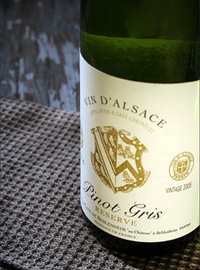 I had to laugh the other night while having dinner in a local restaurant. The patrons next to us ordered a bottle of wine, confidently requesting "Pinot Grisss", with lots of heavy emphasis on the "isssss", as their wine of choice for the evening.
I had to laugh the other night while having dinner in a local restaurant. The patrons next to us ordered a bottle of wine, confidently requesting "Pinot Grisss", with lots of heavy emphasis on the "isssss", as their wine of choice for the evening.
I shouldn't have laughed. Really I shouldn't have. But I'm horrible like that. Don't worry... they didn't hear me. I wanted the waitress to correct them though, "You mean PEE-noh Gree?" but she didn't. Maybe she was worried about her tip or was trying hard not to laugh herself.
I think the intimidation for ordering wine is even greater at fine dining establishments employing a sommelier (sum-muhl-YAY). The sommelier is there to help guide restaurant guests in the best wine choice possible in terms of their meal, palate and pocketbook. It can be intimidating to speak up and request something from somewhere like Chateauneauf-du-Pape (shah-toh-nuhf-doo-PAHP), if you have absolutely NO IDEA how to pronounce the words.
I should be more forgiving. I know for a fact, as many have confessed to me, some people shy away from ordering particular wines simply because they are afraid of making a pronunciation mistake in front of friends and clients.
It makes me wonder if this was the reason Merlot (mer-LOH) was at one time more popular than Cabernet Sauvignon (ka-behr-NAY so-vee-NYAWN).Maybe people were intimidated to pronounce the Sauvignon ending, so they didn't order it! I hope we've gotten over that.
My point is not to ramble on about the mispronunciation of wine varietal names but to talk about a grape I fell in love with after it exploded in wine popularity not long ago. Luckily Pinot Gris enjoyment has not been impeded by the Gris (Gree) ending in its name.
I have loved Pinot Gris since the first time I came in contact with this beautiful, fragrant wine. Maybe it's because in the French region of Alsace, Pinot Gris is considered one of the many "noble grapes". Or could it be the luscious melon and pear aromas with hints of spicy citrus notes that really highlight this wine's unique ability to please.
 When experiencing Pinot Gris from the Alsace region you can also expect an earthiness to come through on the palate, adding complexity to the wines overall nuances.
When experiencing Pinot Gris from the Alsace region you can also expect an earthiness to come through on the palate, adding complexity to the wines overall nuances.
However, when drinking Pinot Gris from the New World, places like Oregon, California and New Zealand, the distinctive earthy terroir (teh-RWAHR) is non-existent and only the more fruity characteristics shine through. This is not a negative quality but is often a notable difference found amongst Old World and New World Pinot Gris.
Also note that Pinot Grigio is the same grape as Pinot Gris. Pinot Grigio is wine produced from grapes grown in Northern Italy. Wines from this region really showcase citrus flavors and tend to be lighter in style.
Overall, Pinot Gris is a wonderful accompaniment to Asian flavored meals, especially stir-fried combinations of shellfish. It also works nicely with grilled chicken or sausages. If you want to pair Pinot Gris with a cheese course I would stick with a mild cheddar or Fontina to start.
If you have never tried Pinot Gris I would highly suggest giving it a try, I think you'll enjoy its whimsical fruitiness.
Cathy is currently in the development stages of her vineyard and winery in the Willamette Valley of Oregon. She is a food writer for Davis Life Magazine and blogs daily about wine, food and everyday living. She currently resides in Northern California with her husband and two sons. You can visit her at noblepig.com.

